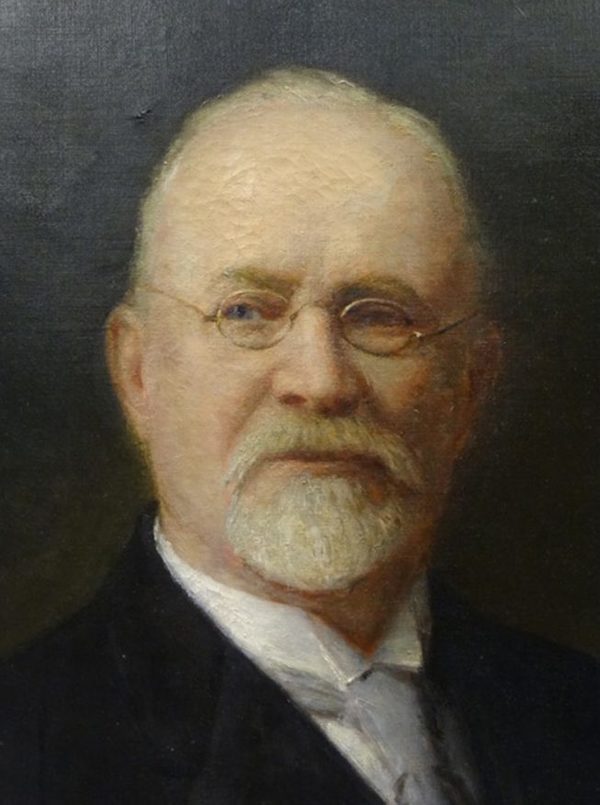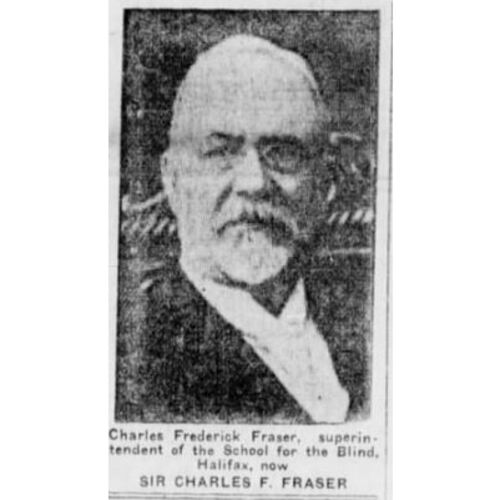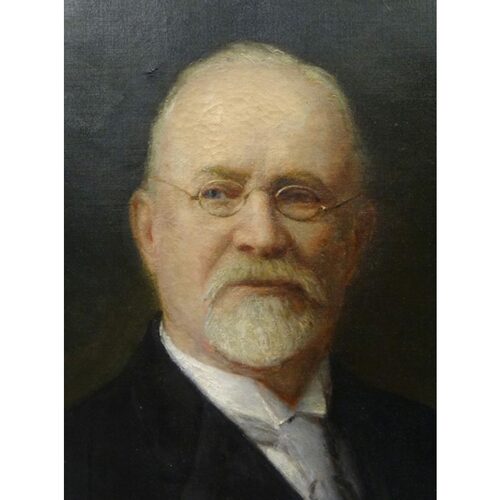
Source: Link
FRASER, Sir CHARLES FREDERICK, educator, editor, and businessman; b. 4 Jan. 1850 in Windsor, N.S., son of Benjamin DeWolf Fraser and Elizabeth Allison; grandson of James Fraser*; m. 28 Sept. 1891 Ella Jane Hunter (d. 1909) in Fredericton; m. secondly 15 June 1910 Jane Catherine Roxby Stevens in Brooklyn, Hants County, N.S., and they had one son; d. 5 July 1925 in Halifax.
When Frederick Fraser was seven years old he injured his eye whittling a stick with a pocket knife. Neither his physician father nor the Boston specialist he consulted was able to repair the damage. Although he attended primary school in Windsor, his eyesight deteriorated steadily, and the sight in his other eye also worsened. At the age of 13, when an operation to create an artificial pupil failed, Fraser was enrolled in the Perkins Institution and Massachusetts Asylum for the Blind in Boston, the first and most famous school for the blind in the United States. By the time he left in 1872 he was completely blind.
The following year, abandoning plans to pursue a career in business, Fraser became the superintendent of the new Halifax Asylum for the Blind. The institution then had only half a dozen students and a small building. By the time Fraser retired in 1923 it had expanded significantly. Enrolments in the 1920s averaged about 120 students a year drawn from all three Maritime provinces and Newfoundland.
The program Fraser developed at the school was nearly identical to that followed at the Perkins Institution. It stressed literacy and the skills required for social and economic independence. The youngest children had kindergarten training, followed by four years of grammar school and six years of high school. Fraser strongly advocated physical education and mobility training, and he introduced gymnastics, walking clubs, and ice skating on the school pond; in 1915 the Halifax Local Council of Women would donate playground equipment. Musical training was at the centre of the curriculum, and many students, such as Arthur M. Chisholm*, were prepared for careers as music teachers, piano tuners, and church organists. For years Fraser himself taught music along with academic subjects and chair-caning. The school’s industrial program also included broom- and basket-making and similar kinds of craft production. In 1891 typewriting was introduced, and over the next decades massage, shampooing, and bookkeeping were added.
Fraser was an indefatigable lobbyist. He regularly travelled through the Maritimes with a group of teachers and students, lecturing and presenting concerts to promote the school and to raise money. He vigorously pressed the provincial government to provide free education for the blind, which was enacted in 1882. Two years later the name of the institution was changed to Halifax School for the Blind to reflect its educational orientation. Fraser established a provincial circulating library of Braille books in 1881, and in 1898 he was successful in persuading the Canadian Post Office to handle Braille books postage-free.
Fraser’s concern for the blind in the Maritimes extended beyond the school. In the 1880s he introduced an extension program, not only to prepare students for attendance at the school, but also to provide instruction to adult blind people in their homes; this work would be formalized in 1893 with the creation of the Home Teaching Society for the Blind of the Maritime Provinces and Newfoundland. By the early 20th century he was advocating prevention of blindness, especially ophthalmia neonatorum which could be successfully treated if identified early enough. In 1911 the Nova Scotia assembly would pass legislation requiring physicians and nurses to report cases of the disease. For many years Fraser promoted the establishment of special workshops for the blind, arguing that the difficulty blind industrial workers had in competing with the sighted made such workshops necessary if they were to lead independent, self-supporting lives. In 1909 he supported the formation of the Maritime Association for the Blind, a self-help group especially concerned with providing employment opportunities. In 1916 he began the Endowment Fund for the Blind to generate additional revenue for the school, the extension movement, the Maritime Association for the Blind, and the Canadian Printing House for the Blind (founded at the school in 1901), and to expand a program of financial assistance, begun in 1883, for graduates embarking on careers or further training. He also supported the Canadian National Institute for the Blind, established in 1918. In that year he served as a consultant to both the Massachusetts Commission for the Blind and the Ontario government, and he presented a number of papers to national and international meetings in his field.
World War I and the Halifax explosion had created an unusual chapter in the history of the school. In 1915 Fraser urged Canada to follow Britain’s lead in training blinded soldiers. By 1917 the school had a small group of Canadian soldiers, but this work ceased in the months following the explosion that year. Not only had the school building been extensively damaged but many parents withdrew their children, exacerbating the school’s financial problems. Moreover, two hundred people were blinded by the explosion, and the school assumed special responsibility for these victims, with help from the Perkins Institution and the American National Red Cross. Training was provided, an eye clinic was established, and extension classes in cooking and sewing were conducted.
Fraser maintained a number of outside interests. He edited a weekly literary and commercial journal called the Critic from 1884 to 1894 when it was merged with the Canadian Colliery Guardian (Halifax). A long-standing member of the North British Society, he was elected president for 1885. He was the first president of the Halifax Canadian Club and a vice-president of the Halifax Archaeological Institute; in 1908 he was a promoter of the Nova Scotia League for the Care and Protection of Feeble-minded Persons. He worked as well in the Electoral Reform League and the British Empire League. Pursuing his early interest in business, he served as president of Nova Scotia Telephone and Trinidad Consolidated Telephone and as a director of a number of firms including Eastern Trust and Empire Trust.
Fraser’s contribution to the welfare of the blind was significant and he received many tributes, including honorary degrees from King’s College in Windsor and Dalhousie University in Halifax and special recognition from the provincial legislature in 1913. In 1915 he was knighted on the recommendation of his lifelong friend Sir Robert Laird Borden*. Although more honoured than many, Fraser was in a number of respects typical of those who supervised benevolent institutions in the 19th century. He himself had received specialized training, he worked in a specialized institution supported by philanthropy and the state which emphasized independence and employability, and he was interested in a number of reform causes. However, he was unusual in two ways, first because he shared the disability of his charges, and secondly because, unlike most of his colleagues, who were drawn from the lower middle class, he was a member of the social and economic elite of the province. At the time of his death he left a large estate which included two houses, his home in south-end Halifax and a summer residence in suburban Bedford, and substantial annuities to five of his extended family and friends in addition to the support provided for his widow and son.
Halifax County Court of Probate (Halifax), Estate papers, 17: 104 (mfm. at NSARM). Critic (Halifax), 7 (1890); 8 (1891). Evening Echo (Halifax), 6 July 1925. Evening Mail (Halifax), 6 July 1925. Halifax Herald, 6 July 1925. Morning Chronicle (Halifax), 6 July 1925. Annals, North British Society, Halifax, Nova Scotia, with portraits and biographical notes, 1768–1903, comp. J. S. Macdonald ([3rd ed.], Halifax, 1905). M. R. Chandler, A century of challenge: the history of the Ontario School for the Blind (Belleville, Ont., 1980). A genealogical and heraldic history of the peerage and baronetage . . . , ed. A. P. Burke (80th ed., London, 1921). Halifax Asylum for the Blind, Report of the board of managers, 1872–78. Halifax Institution for the Blind, Report of the board of managers, 1879–84. Halifax School for the Blind, Annual report of the board of managers, 1884–1925. M. A. E. A. McNeil, The blind knight of Nova Scotia: Sir Frederick Fraser, 1850–1925 (Washington, 1939). Nova Scotia newspapers: a directory and union list, 1752–1988, comp. Lynn Murphy et al. (Halifax, 1990). Harold Schwartz, Samuel Gridley Howe, social reformer, 1801–1876 (Cambridge, Mass., 1956). A survey and listing of Nova Scotia newspapers, 1752–1957, with particular reference to the period before 1867, comp. G. E. N. Tratt (Halifax, 1979).
Cite This Article
Janet Guildford, “FRASER, Sir CHARLES FREDERICK,” in Dictionary of Canadian Biography, vol. 15, University of Toronto/Université Laval, 2003–, accessed January 21, 2025, https://www.biographi.ca/en/bio/fraser_charles_frederick_15E.html.
The citation above shows the format for footnotes and endnotes according to the Chicago manual of style (16th edition). Information to be used in other citation formats:
| Permalink: | https://www.biographi.ca/en/bio/fraser_charles_frederick_15E.html |
| Author of Article: | Janet Guildford |
| Title of Article: | FRASER, Sir CHARLES FREDERICK |
| Publication Name: | Dictionary of Canadian Biography, vol. 15 |
| Publisher: | University of Toronto/Université Laval |
| Year of revision: | 2005 |
| Access Date: | January 21, 2025 |




